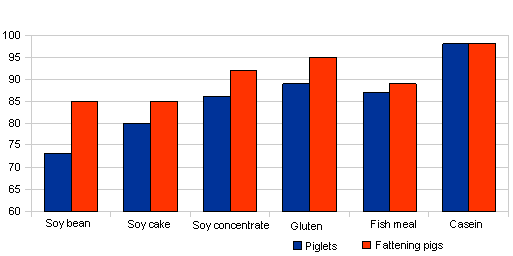Introduction
To maximize piglet growth, it is recommended that levels of crude protein be at 20-23% in pre-starters and 18-20% in starters. However, part of that crude protein will not be digested at the end of the ileum, and it will enter the large intestine together with the endogenous waste. This will promote the growth of the proteins’ fermenting bacteria and will affect other final products such as branched-chain fatty acids, ammonia, phenolic compounds, as well as biogenic indols and amines that could be potentially damaging and that could be involved in the post weaning diarrhea’s aetiology. For that reason a diet low in protein as a prevention factor for piglet diarrhea has been suggested.
Ingredients
The digestibility of crude protein is seen to be compromised after weaning, so the selection of highly digestible ingredients with high absolute values is very important (see Fig 1).
The use of trustable sources of lactic protein, animals and vegetable protein concentrates, with high digestibility values and low antinutritive factors is recommended. It is also important to determine the palatability and the combination of the different sources of protein with complimentary amino acid profiles in order to achieve the ideal protein mix.
Also, one should consider that certain ingredients can contain active substances or principles with beneficial effects apart from the simple nutrient supply (e.g. immunoglobulin, omega 3, bioactive proteins, etc).

Fig 1. Digestibility coefficient of crude protein in piglets and fattening pigs
Nutrients
Upon reducing the protein level of the piglet feed, it is necessary to keep the following in mind:
• Nutrition density and the lysine/energy ratio, parameters that will probably be reduced.
• Conveniently balance the ideal protein profile with synthetic amino acids; in this case the recent availability of valine is useful. However, it is necessary to avoid possible secondary essential amino acid deficiencies.
• In compromised sanitary conditions, the ratio of certain amino acids related to immune system activation can increase.
Although amino acid supplementation is quickly becoming a common commercial practice, it’s difficult to apply in starter diets without causing a potentially dangerous, non essential amino acid deficiency. So, a moderate reduction is rather feasible and will have an irrelevant impact on production (approximately 2 to 3%, up to 17% of crude protein), but it is worth noting that reductions of more than 4% will most likely have a negative effect on production.
Immunity
Lately, several studies have been published showing decreased intestinal inflammation due to E. coli with low protein diets.
The hypothesis is that less protein in the diet reduces the available surface area for the proliferation of E. coli and the colonization of the intestinal epithelium, therefore reducing the inflammatory reaction associated with the infection including the production of pro-inflammatory cytokines and acute phase proteins. It has also been suggested that the shortage of protein in the piglets fed low-protein diets compromises the immunological reaction (a hypothesis clearly demonstrated in the case of malnutrition).
Although the secretion of pro-inflammatory cytokines like IL-1β and TNF-α is beneficial for the activation of immune cells used to combat infection and eliminate pathogens, this can compromise the availability of nutrients in the diet used for growth optimization.
Fermentation
There is a disparity among the results about the increased fermentation of protein and the production of branched-chain fatty acids upon supplying high-protein diets, as well as with the increased absorption of this nutrient in the large intestine. It is suggested that, if available, the micro flora prefers to use fermentable carbohydrates before the fermented proteins.
Moreover, recent studies have seen an increased production of butyric acid in diets with a decreased proportion of protein to fermentable carbohydrates.
Also, a synergetic effect in diets high in protein and lactose has been seen in productions, fermentation, and intestinal microbiology.
Morphology and intestinal maturation
Different authors, upon using low-protein diets, have observed a certain level of atrophy in the intestinal villus, as well as decreased activity of the mucus disaccharides, indicative of a lack of intestinal maturation. This fact supposes decreased efficiency in the digestive use of the diet and a loss of growth. Supplementation with glutamine or arginine can prevent these effects.
On the other hand, in diets that have a surplus of protein, heavier internal organ weight and increased intestinal crypt depth (possible hypertrophy due to damaged mucous membrane) have been noted.
Conclusions
When designing piglet diets one has to consider the beneficial effects of low protein levels over the risk of diarrhea and its potential negative effects on growth. The inclusion of highly digestible protein sources in starter diets is a way to maintain productions as well as health.





